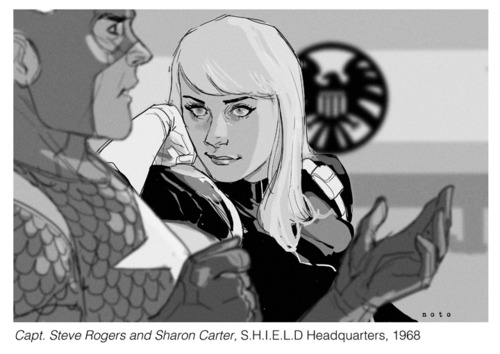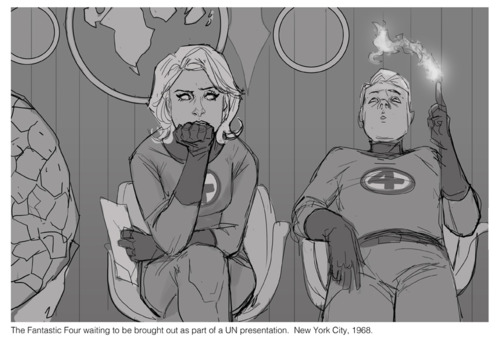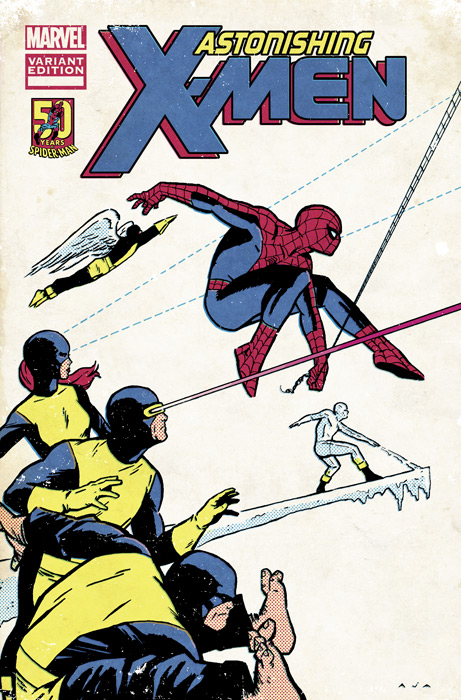Phil Noto: From the Hank Pym Photo Archives
Phil Noto is sporadically posting assorted artwork *From the Hank Pym Photo Archives*, capturing various Marvel heroes in daily life.


2013-02-19
“Actually I use Rdio, Not Spotify, Your Link Is No Good To Me”
Tyler Hayes posits another argument for YouTube music:
Is there an etiquette for sharing music? A link to any of the music services, even the most popular ones, will inevitably fall on a few deaf ears of people you’re trying to reach. Not for lack of interest in the music, but rather in having to use a specific service. Since it’s 2013, you can’t just listen to music anymore, you need to be tied into an ecosystem. So, what’s the right way to share music, and actually get the other person to click through and listen?
2013-02-19
Music, money, and YouTube
Lots of talk recently about the mechanics and economics of the various streaming music services - Spotify, Rdio, Mog, and Pandora being the most visible examples. $10 a month for all the music all the time? Sounds like a bargain. However making sense of the economics of it from an artist’s perspective is hard.
Pandora’s founder penned an impressive post about the bundles of cash his service is handing out to artists, which whilst sounding great in theory, was quickly stomped on by music industry guys like Bob Lefsetz (in a typically vitriolic rant), and perhaps more damningly by musicians like Galaxie 500 who report Pandora has given them all of $0.21c for the 7800 plays of one of their tracks.
Meanwhile Spotify finds funding that values the company at $3 *billion* despite losing $59 million in 2011, all of which supports Galaxie 500’s reasoning that, like a Sex Pistols reunion tour, these companies are only in it for the money:
These aren’t record companies– they don’t make records, or anything else; apparently not even income. They exist to attract speculative capital. And for those who have a claim to ownership of that capital, they are earning millions– in 2012, Pandora’s executives sold $63 million of personal stock in the company. Or as Spotify’s CEO Daniel Ek has put it, “The question of when we’ll be profitable actually feels irrelevant. Our focus is all on growth. That is priority one, two, three, four and five.”
Everyone agrees that the physical CD era is over 1, but the model to replace it is still being thrashed out:
It’s all about crowdfunding. Streaming is the answer. Streaming services will kill you and then themselves. Vinyl is the future. There’s no retail any more. Amazon is the enemy. Amazon is your friend. The labels are dead. Long live the labels. It’s all about distribution. We need a new format. Formats don’t matter any more.
What doesn’t seem to be discussed in all this coverage of how to make money from music is how people—particularly the lucrative ‘youth’—are actually listening to and finding new music.
The answer, according to my highly scientific polling of my nieces, nephews and assorted other under forties, is YouTube. Instead of radio, or CDs, or streaming audio, they all turn to YouTube when they want to listen to *or discover* music. The related links rabbit hole leads them to new and unheard music. Which is the role a good DJ plays on radio: challenging you with new sounds that flow seamlessly from music you already know.
This is quite foreign to old school stereo music nerds. Why go to a video site to listen to music? Pretty easy really - it’s free, it’s visual, it’s bottomless (like the streaming services), it’s shareable, and you can enjoy it on your iToy or PC or pretty much anywhere. More configurable than radio, and cheaper than Spotify. And YouTube even pays artists some kind of meagre royalty.
Maybe [Buggles][bug] were right. [bug]:http://www.youtube.com/watch?v=Iwuy4hHO3YQ
-
Although Tim Bray manages to find some saving graces. ↩︎
2013-02-17
Letterboxd movies
Letterboxd, a site for tracking your movie viewing habits, has just opened it’s doors to all 1, having being in an invitation-only beta for some time.
It’s a great way of keeping tabs on your films – you can create lists, rate, review, and connect to friends also using Letterboxd. The design is top notch, and incorporates movie data and artwork from tmdb (a crowd sourced IMDB).
Best thing? They’re kiwis. Definitely worth checking out if you’ve struggled to stay on top of your film history.
-
Including a new ‘Pro’ option for $20/year. The main feature of Pro is Netflix integration, so not much use outside North America, but it’s a good way to support the site if you like it. ↩︎
2013-02-09
The price of Lego
Staggeringly detailed data mining to work out if the common refrain of “Lego is too expensive *these days*” holds any weight. Spoiler: nope. (via John Siracusa)
2013-02-09
Comics & Variant Covers
I’ve recently started buying single issue comics again (as opposed to trade paperbacks), tempted back largely by following Merlin Mann’s relentless love of all things X.
I’m buying physical issues despite the temptation of Comixology, as I enjoy the form of a comic book1: the cover, splash pages, page-turn-anticipation, the cover, oh and the cover. I also worry about Comixology’s DRM lockdown. It’s strange and frustrating how ebooks/comics are stuck in the DRM world years after music escaped.
Monthly issues are a funny thing - once they’re gone, they’re gone. They’re like small pieces of art that exist in a temporal field that lasts only a few months2. Which makes the weekly trip to the comic shop a fun adventure in spotting what’s new and grabbing it before it’s gone for good.
One thing I’ve noticed since venturing back into Sydney CBD’s sole surviving comic store is the fantastic variant covers that are being created. It seems that most issues–or at least most issue of the big series–are coming out with limited edition variant covers, and they often are spectacular.

David Aja's Astonishing X-Men #48 variant
Making the covers limited are an extremely transparent sales & marketing ploy by the publishers, but that doesn’t take away from their artistic merit. There is some beautiful work on show. The trouble is that buying the issues is impossible unless you like burning money. My shop sells the ‘limited limited’ covers for $50, the slighty-less-limited for $15, etc. They never make it to the shelves for the cover price of ~$53. This kind of policy has been the subject of some heated debate amongst the retail fraternity, and I guess it’s tough making a living selling comics these days.
Marvel’s offical artwork archive is nigh on impossible to navigate sensibly, and the various user generated comic database sites are woefully incomplete and disorganised.
Given a tiny percentage of (well off) readers can lay their hands on them, why not at least make the digital covers easily available? As it stands, tumblr is easily the best way to find comics artwork. West Coast Avengers, and authors Brian Michael Bendis, Matt Fraction, and Kelly Sue DeConnick are all reliable sources of the good stuff.
-
As a bonus, buying a real-world copy of some $3.99 books grants you a digital copy too. ↩︎
-
I’ve always enjoyed magazines for the same reason: if you don’t buy it when it’s on the shelves, it very difficult to get it later. ↩︎
-
There are some standard-variants that go for cover price, but the real standouts don’t The real shame is that there doesn’t even seem to be an online archive of the variants. ↩︎
2013-02-09
2012
The short version: this year intentionally left blank. The longer version: For no good reason I stopped posting in early 2012. For no particular reason, though I tired a little of the linkblog format, and tumblr wasn’t really the right place. It’s a hell of a job getting your data out of tumblr (and it is *your* data). They don’t provide an export tool, which is unacceptable these days, especially for something as huge as tumblr.
Eventually I pulled it all into wordpress.com, extracted that to XML, manually removed all the tumblr guff, and ended up with this site. My own domain, self hosted, and much more permanent. Here’s to 2013.
2013-02-06